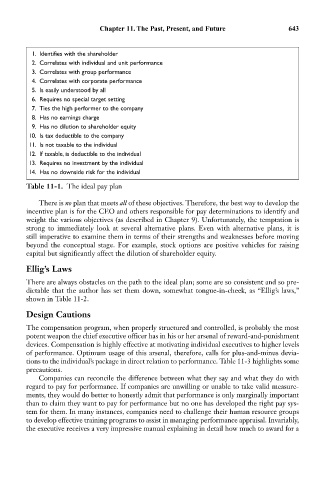Page 658 - Bruce Ellig - The Complete Guide to Executive Compensation (2007)
P. 658
Chapter 11. The Past, Present, and Future 643
1. Identifies with the shareholder
2. Correlates with individual and unit performance
3. Correlates with group performance
4. Correlates with corporate performance
5. Is easily understood by all
6. Requires no special target setting
7. Ties the high performer to the company
8. Has no earnings charge
9. Has no dilution to shareholder equity
10. Is tax deductible to the company
11. Is not taxable to the individual
12. If taxable, is deductible to the individual
13. Requires no investment by the individual
14. Has no downside risk for the individual
Table 11-1. The ideal pay plan
There is no plan that meets all of these objectives. Therefore, the best way to develop the
incentive plan is for the CEO and others responsible for pay determinations to identify and
weight the various objectives (as described in Chapter 9). Unfortunately, the temptation is
strong to immediately look at several alternative plans. Even with alternative plans, it is
still imperative to examine them in terms of their strengths and weaknesses before moving
beyond the conceptual stage. For example, stock options are positive vehicles for raising
capital but significantly affect the dilution of shareholder equity.
Ellig’s Laws
There are always obstacles on the path to the ideal plan; some are so consistent and so pre-
dictable that the author has set them down, somewhat tongue-in-cheek, as “Ellig’s laws,”
shown in Table 11-2.
Design Cautions
The compensation program, when properly structured and controlled, is probably the most
potent weapon the chief executive officer has in his or her arsenal of reward-and-punishment
devices. Compensation is highly effective at motivating individual executives to higher levels
of performance. Optimum usage of this arsenal, therefore, calls for plus-and-minus devia-
tions to the individual’s package in direct relation to performance. Table 11-3 highlights some
precautions.
Companies can reconcile the difference between what they say and what they do with
regard to pay for performance. If companies are unwilling or unable to take valid measure-
ments, they would do better to honestly admit that performance is only marginally important
than to claim they want to pay for performance but no one has developed the right pay sys-
tem for them. In many instances, companies need to challenge their human resource groups
to develop effective training programs to assist in managing performance appraisal. Invariably,
the executive receives a very impressive manual explaining in detail how much to award for a

